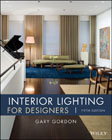
This revised edition of the successful primer thoroughly covers fundamentals of lighting design, and also serves as a handy reference for professional designers. The Fifth Edition is more comprehensive than ever, with new information on LED, energy efficiency, and other current issues. In addition, it includes more information for drawing ceiling floor plans and the application of designs to specific types of interiors projects. Considered a key reference for the Lighting Certified exam, no other text combines both technical and creative aspects of lighting design for beginners and novice designers. INDICE: Chapter 1 The Lighting Design Process Chapter 2 Perception and Vision Perception of the world around us is based not on the quantity of light entering the eye, but on the quantity of contrast. Visible Light The Eye and Brain Brightness Perception Color Perception The Sense of Sight Chapter 3 Light and Health Much as the ear has two purposes—for hearing and balance—so does the eye. Light entering the eye gives rise to vision—and also governs the daily rhythms in all animals, including humans. Photobiology and Nonvisual Effects The Aging Eye Seasonal Affective Disorder Assisted–Living and Elder–Care Facilities Chapter 4 Psychology of Light Because the sense of sight is contrast sensitive, the brightness contrast of a space determines its emotional impact. Emotional Impact Degrees of Stimulation Degrees of Brightness Contrast Low–Contrast Environment High–Contrast Environment The Three Elements of Light Subjective Impressions Impressions of Spaciousness Impressions of Perceptual Clarity Impressions of Pleasantness Vertical Surface illumination Certainty Variation Chapter 5 Patterns of Brightness Specifying the direction and distribution of light in a space yields the desired brightness contrast. Brightness vs Luminance Direction and distribution of light Surface Finishes and Reflectances Secondary Light Sources Three–Dimensional Form Glare and Sparkle Direct Glare Visual Comfort Probability (VCP) Reflected Glare Sparkle Chapter 6 Color of Light Color is not a physical property of the things we see—it is the consequence of light waves bouncing off or passing through various objects. Color Temperature Color Rendering Subjective Impressions Surface Finishes and Color of Light Incandescent Sources Fluorescent Sources High–Intensity Discharge (Hid) Sources Chapter 7 Measurement of Light Quantitative Illumination Measurement Limitations Luminous Intensity Distribution Curve Chapter 8 Daylight Daylight Design Fenestration Sections Tubular Skylights Managing Solar Heat Gain Shading Devices Movable Controls Stationary Controls Glazing Materials Quantity of Interior Daylight Chapter 9 Incandescent and Halogen Lamps Lamp Bases Filaments Light Output Lamp Types Nondirectional Sources Semi–Directional Sources Directional Sources R Lamps AR and MR lamps PAR Lamps U.S. Legislation EPACT EISA Tungsten–Halogen Lamps Halogen Infrared (IR) Lamps Low–Voltage Lamps Colored Light Color Filters Colored Lamps Chapter 10 Low–Intensity Discharge Lamps
- ISBN: 978-0-470-11422-3
- Editorial: John Wiley & Sons
- Encuadernacion: Cartoné
- Páginas: 320
- Fecha Publicación: 10/01/2014
- Nº Volúmenes: 1
- Idioma: Inglés
